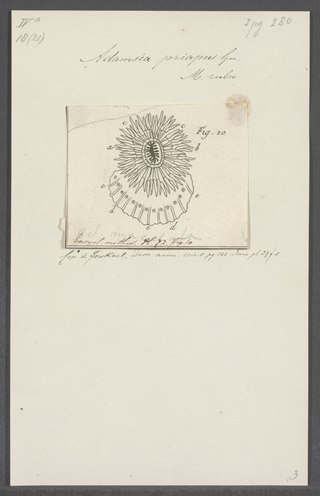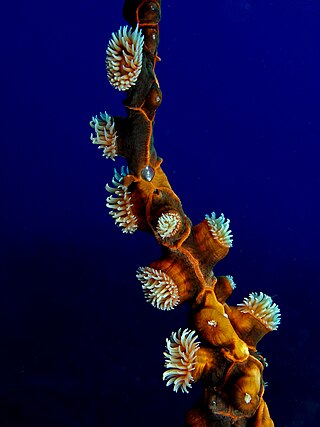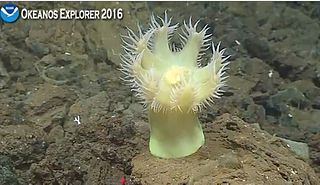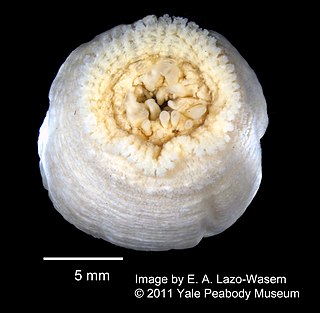
Calliactis is a genus of sea anemones. Species in this genus are mutually symbiotic with hermit crabs. The anemone gets a place to live and discarded scraps of the crab's food in exchange for its help in defending the crab.

Actiniidae is the largest family of sea anemones, to which most common, temperate, shore species belong. Most members of this family do not participate in symbioses with fishes. Three exceptions are the bubble-tip anemone, snakelocks anemone and Urticina piscivora.

Aiptasia is a genus of a symbiotic cnidarian belonging to the class Anthozoa. Aiptasia is a widely distributed genus of temperate and tropical sea anemones of benthic lifestyle typically found living on mangrove roots and hard substrates. These anemones, as well as many other cnidarian species, often contain symbiotic dinoflagellate unicellular algae of the genus Symbiodinium living inside nutritive cells. The symbionts provide food mainly in the form of lipids and sugars produced from photosynthesis to the host while the hosts provides inorganic nutrients and a constant and protective environment to the algae. Species of Aiptasia are relatively weedy anemones able to withstand a relatively wide range of salinities and other water quality conditions. In the case of A. pallida and A. pulchella, their hardiness coupled with their ability to reproduce very quickly and out-compete other species in culture gives these anemones the status of pest from the perspective of coral reef aquarium hobbyists. These very characteristics make them easy to grow in the laboratory and thus they are extensively used as model organisms for scientific study. In this respect, Aiptasia have contributed a significant amount of knowledge regarding cnidarian biology, especially human understanding of cnidarian-algal symbioses, a biological phenomenon crucial to the survival of corals and coral reef ecosystems. The dependence of coral reefs on the health of the symbiosis is dramatically illustrated by the devastating effects experienced by corals due to the loss of algal symbionts in response to environmental stress, a phenomenon known as coral bleaching.

Adamsia is a genus of sea anemones in the family Hormathiidae. Species in this genus are mutually symbiotic with hermit crabs. The anemone gets a place to live and discarded scraps of the crab's food in exchange for its help in the crab's defence. As these anemones grow, they secrete a horny membrane, known as a carcinoecium, which overlies the crab's original snail shell and expands the living space of the crab. This means the anemone does not have to change substrate and the crab does not have to seek a larger shell as they both grow.

Amphianthus is a genus of sea anemones. It is the only genus in the monotypic family Amphianthidae.

Anthothoe is a genus of sea anemones in the family Sagartiidae.

Bunodosoma capense, commonly known as the knobbly anemone, is a species of sea anemone in the family Actiniidae.

Bunodactis is a genus of sea anemones in the family Actiniidae.

Epiactis is a genus of sea anemones in the family Actiniidae. There are about nineteen recognised species and the type species is Epiactis prolifera.

Urticina is a genus of relatively large and often colorful sea anemones in the family Actiniidae from the North Pacific, North Atlantic and Arctic Oceans.

Actinia is a genus of sea anemones in the family Actiniidae. Actinia display a rare form of heteromorphosis in which a cut inflicted on a specimen can develop into a second mouth.

Sagartia is a genus of sea anemones in the family Sagartiidae. The genus was first described by Philip Henry Gosse in 1855 and the image is his painting of several species found in British waters included in his book, A history of the British sea-anemones and corals.

Ceriantheopsis is a genus of tube-dwelling anemones in the family Cerianthidae. Members of the genus are found only in the Atlantic Ocean. They are predators, scavengers and omnivores.

Anemonia is a genus of sea anemones belonging to the family Actiniidae.
Cangitoxin, also known as CGTX or CGX, is a toxin purified from the venom of the sea anemone Bunodosoma cangicum, which most likely acts by prolonging the inactivation of voltage-gated sodium channels.

Exaiptasia is a genus of sea anemone in the family Aiptasiidae, native to shallow waters in the temperate western Atlantic Ocean, the Caribbean Sea and the Gulf of Mexico. It is monotypic with a single species, Exaiptasia diaphana, and commonly known as the brown anemone, glass anemone, pale anemone, or simply as Aiptasia.

Diadumene is a genus of sea anemones. It is the only genus in the monotypic family Diadumenidae.

Haloclava is a genus of sea anemones in the family Haloclavidae. Members of this genus typically burrow into soft sediment.

Actinernidae is a family of sea anemones. It contains the following genera and species:

Actinostella is a genus of sea anemones in the family Actiniidae.


















